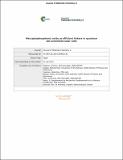Files in this item
Mercaptophosphonic acids as efficient linkers in quantum dot sensitized solar cells
Item metadata
| dc.contributor.author | Aldakov, D. | |
| dc.contributor.author | Sajjad, Muhammad Tariq | |
| dc.contributor.author | Ivanova, V. | |
| dc.contributor.author | Bansal, Ashu Kumar | |
| dc.contributor.author | Park, Jinhyung | |
| dc.contributor.author | Reiss, P. | |
| dc.contributor.author | Samuel, Ifor David William | |
| dc.date.accessioned | 2016-08-15T23:33:03Z | |
| dc.date.available | 2016-08-15T23:33:03Z | |
| dc.date.issued | 2015-10-07 | |
| dc.identifier | 225577161 | |
| dc.identifier | 659b1d19-b083-4465-b387-04fb29eb1acb | |
| dc.identifier | 84941755732 | |
| dc.identifier | 000361553100031 | |
| dc.identifier.citation | Aldakov , D , Sajjad , M T , Ivanova , V , Bansal , A K , Park , J , Reiss , P & Samuel , I D W 2015 , ' Mercaptophosphonic acids as efficient linkers in quantum dot sensitized solar cells ' , Journal of Materials Chemistry A , vol. 3 , no. 37 , pp. 19050-19060 . https://doi.org/10.1039/c5ta04021c | en |
| dc.identifier.issn | 2050-7488 | |
| dc.identifier.uri | https://hdl.handle.net/10023/9307 | |
| dc.description | This work was supported by the Agence Nationale de la Recherche, project QuePhélec (ANR-13-BS10-0011-01). MTS and IDWS are thankful to ERC for financial support for exciton diffusion project, grant number 321305. AKB and IDWS also acknowledge financial support from EPSRC programme grant: structured light, EP/J01771X. | en |
| dc.description.abstract | Control over the deposition of quantum dots (QDs) on nanostructured semiconductors is very important for the photovoltaic performance of QD sensitized solar cells. The best control is typically achieved using bifunctional molecular linkers, such as mercaptopropionic acid (MPA), to attach the QDs to metal oxides in a specific manner; however some materials, such as ZnO, are not compatible with these molecules due to their pH sensitivity. We have developed new linkers, mercaptophosphonic acids of different length, which allow efficient functionalization of ZnO nanowires and also mesoporous TiO2 without damaging their surface. Detailed XPS and contact angle studies of the mechanism of self-assembly of these acids show that their strong chelation of the oxide surface prevents protonic attack and etching. Using these linkers, we show that colloidal ternary quantum dots, CuInS2, can be conformally and homogeneously deposited on the functionalized metal oxides. Photophysical studies by means of time-resolved photoluminescence spectroscopy confirm efficient electron transfer from the QDs to the metal oxides with the rate and efficiency scaling with respect to the linker length and nature. The efficiency of the QD sensitized solar cells fabricated with such assemblies also strongly depends on the linkers used and follows the trends observed for the charge transfer. | |
| dc.format.extent | 11 | |
| dc.format.extent | 815255 | |
| dc.language.iso | eng | |
| dc.relation.ispartof | Journal of Materials Chemistry A | en |
| dc.subject | QD Chemistry | en |
| dc.subject | NDAS | en |
| dc.subject | SDG 7 - Affordable and Clean Energy | en |
| dc.subject.lcc | QD | en |
| dc.title | Mercaptophosphonic acids as efficient linkers in quantum dot sensitized solar cells | en |
| dc.type | Journal article | en |
| dc.contributor.sponsor | EPSRC | en |
| dc.contributor.sponsor | European Research Council | en |
| dc.contributor.institution | University of St Andrews. School of Physics and Astronomy | en |
| dc.contributor.institution | University of St Andrews. Condensed Matter Physics | en |
| dc.identifier.doi | https://doi.org/10.1039/c5ta04021c | |
| dc.description.status | Peer reviewed | en |
| dc.date.embargoedUntil | 2016-08-15 | |
| dc.identifier.url | http://www.rsc.org/suppdata/c5/ta/c5ta04021c/c5ta04021c1.pdf | en |
| dc.identifier.grantnumber | EP/J01771X/1 | en |
| dc.identifier.grantnumber | en |
This item appears in the following Collection(s)
Items in the St Andrews Research Repository are protected by copyright, with all rights reserved, unless otherwise indicated.

